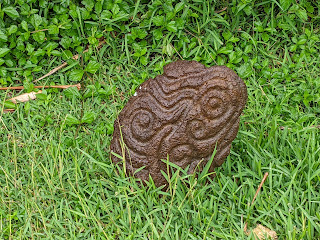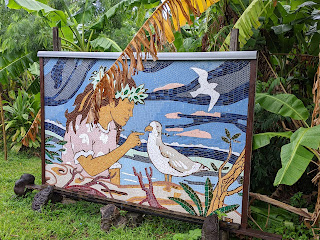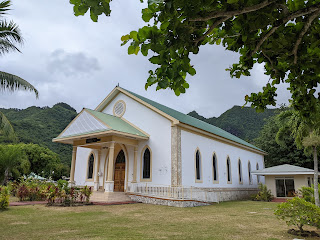That morning Steven and I returned to what had immediately become our favorite beach on the French Polynesian island of Moorea. We didn't stay as long as we'd hoped because the clouds rolled in to cut our time in the sun short. Liesbet: As you can see, the bay was a favorite place for lots of sailboats. The views of the storm clouds moving in and out over the mountains captivated us until we finally decided to take the opportunity to drive around the entire island.
This Daily Travelogue is a labor of love for our families and friends at home and around the world. Prior to 2020, all our trips were documented on separate, yearly blogs which can be accessed below. Remember that clicking on any picture will open it for better viewing. Also, please consider adding your name at the end of any comments. Be safe, stay healthy, and stay connected.
Tuesday, February 8, 2022
12/19/21: More of Magical Moorea!
French Polynesia seemed to be about the last place I'd have expected to see images of polar bears!
These interesting sculptures caught our attention. Only the first one was by a business. Because of the drizzle, the photos aren't as clear as I'd have liked.
I would think the figures' hands placement had a special significance but don't know what they might have been.
An example of a French Polynesian mile marker or rather kilometer marker to be accurate! It was known as a PK which I'm thinking stands for Polynesian Kilometer with PK 0 starting in Papetoai, the 'capital of Moorea.'
Just after the distance marker was a huge concrete Tahitian warrior outside the now-closed Painapo Beach Paradise Restaurant.
I had no idea if there was any significance to all the sculptures by the warrior or close to the beach but we'd never seen anything like it at any other beach in French Polynesia.
We were glad that the restaurant was closed as otherwise, we would have to have paid to access the beach and it sure wasn't worth spending money on!
In the village of Haapiti in southern Moorea was the twin-towered Eglise de la Sainte Famille that was once the head church of the island's Catholic mission. It was built in 1891. Like all but two other churches we'd hoped to enter in the least three weeks on the islands, it was also closed.
Beginning in 1821, the children of the missionaries and the Tahitian chiefs were taught by the Academy of the South Seas that was established by the London Missionary Society.
As we drove past close to 75 children and adults walking along the side of the road, we couldn't help but wonder where they were going!
It turned out it was the small community of Afareaitu, southern Moorea's administrative center, and also the island's second center of missionary activity. At the Afareaitu printing works in 1817, King Pomare II ceremonially printed the first page of the first book ever published on a South Pacific island. It was a Tahitian translation of the Gospel of St. Luke. Before the printing press was moved to the island of Huahine a year later, more than 9,000 books totaling more than a half-million pages had been printed in Afareaitu.
The Protestant temple in Afareaitu:
At the southernmost point of the island was the ferry terminal for boats leaving for Pape'ete on Tahiti. After the sublime time we'd been enjoying these last few days on Moorea, we definitely weren't looking forward to being on one of these ferries as it would mean the end of our vacation!
Some glorious views as we headed back north again toward Cook's Bay and our rental property:
Several days ago, our French property owner, Cathy, had generously offered to drive us to a pineapple plantation in the center of the island because the four-kilometer dirt road was only accessible via her 4x4 Jeep.
Cathy pointed out this breadfruit tree and mentioned that explorer James Cook had wanted to return here to Moorea to get some of the fruit for his slaves.
Cathy's dogs had the privilege of sitting in the front seat with her! One of them got so excited in the jeep that he actually jumped out of the window. He didn't get hurt, luckily, as the poor conditions of the road made for very slow driving.
Though we'd certainly experienced some rain and overcast skies while on Moorea, we still counted ourselves very lucky when Cathy said it was pretty common for it to rain six to seven days straight from October to February. To think our entire time on Moorea could have been ruined because of rain was nothing we wanted to contemplate.
Bet you can tell why the road was called Pineapple Road, huh?!! Pineapples can only be planted every four years before getting too old. Baby plants are planted beside a 'mother' plant.
The mountains all around us meant we were in the center of the volcano.
While the dogs ran off to play for a bit, Cathy explained that pineapple growing was a very labor-intensive process as they each had to be hand-grown and hand-picked, a job that not many people wanted. The decision was made in 1980 to plant pineapples for use exclusively by residents of French Polynesia, partly because the pineapples were all different sizes which meant they couldn't be exported.
Ever since we'd been kayaking on the island of Raiatea near the beginning of our trip, Steven and I had seen oodles and oodles of these trees and their pretty pale yellow blossoms. Thanks to Cathy, we now knew it was a pouron tree and that its leaves were used were used in a baby's bath as part of Polynesian culture.
This grass was used to create perfumes - how appearances can be deceiving!
It was very unusual to see coconut palms at this high elevation, according to Cathy, as they are normally only found at sea level. They were only found here because the farmworkers had planted them as they wanted shade when picking pineapples!
Another view of the pineapple plantation: notice how irregular the pineapple plants are planted, how 'messy' the area is. We were told that was because no chemicals were used in this part of the plantation.
Through our tiny side window, we could see some avocado trees that had been brought from California. Cathy told us that they were used to catch 'bad spirits.'
Looking back on the narrow road we'd just traveled on through the plantation:
If I wasn't able to convince you in any of my previous posts of Moorea's beauty, I sure hope this one does as I came away spellbound from this introduction to the island's agricultural heritage.
Did you ever know that just one flower is able to produce all these bananas?! I never did, that's for sure.
If Cathy's informative tour of the plantation hadn't been thrilling enough, she then drove the jeep through the rock-strewn creek. It was bumpy as all get out in the tiny rear seat but that made it it even more fun!
Cathy told us these pineapples were just three months old.
We noticed immediately the even rows in this next pineapple plantation and the fact that there was no grass growing between the rows. Cathy said that was due to chemicals being applied to this area in the new plantation.
Cathy told us the young pineapple plants were red in color before turning purple when they age.
Cathy stopped for a moment to pick some mangoes from one of these trees.
Taro was one of the main foodstuffs on the island. If Cathy hadn't mentioned it, I don't think I'd have observed that the earth was black on this side of the crater. That was because of the volcano, she said.
Hold on tight for a ride through another creek!
You can see there was no way this drive could have been accomplished in anything but a 4x4.
When Cathy suggested we next take the dogs for a walk on a triathlon course, we were all in!
This majestic-looking tree was called a falcata and was one I'd never heard before. I learned its soft wood was only good for matches and wood pallets.
Cathy picked some guavas for us to taste but Steven didn't feel for one. I tried it but thought it was pretty bland and wouldn't go out of my way to eat one again.
I think the real reason Cathy wanted us to go on this hike was so she could show off the island's oldest tree which was estimated to be from 400-500 years old. It had even survived cyclones that had hit Moorea!
In the foreground was the pineapple plantation we'd just driven through. In the background was the Rota Nui mountain.
Even though the weather didn't cooperate in the morning to allow us to spend a few hours at the beach, that didn't matter one iota as our own fun drive around the entire island was followed by a really thrilling and informative ride with Cathy. The day just cemented our overall opinion of Moorea being magical!
Next post: Sadly, our last two days on Moorea and of all of French Polynesia but all good things must come to an end as 'they' say!
Posted very early on February 8th, 2022, from sunny and warm Phoenix where we came for the month to escape Denver's winter doldrums. As Steven and I keep reminding each other, how lucky are we to travel far and wide even as so many of our countrymen are infected with Covid daily.
Subscribe to:
Post Comments (Atom)


























































































No comments:
Post a Comment